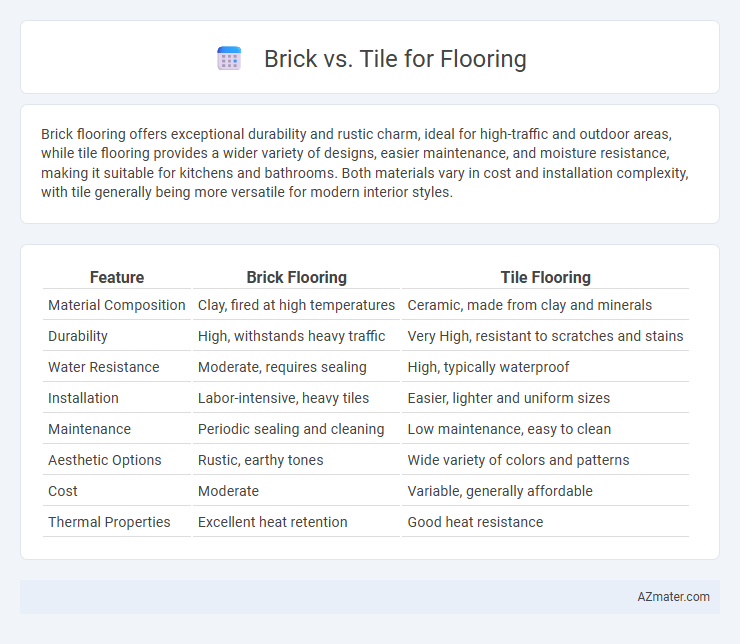Brick flooring offers exceptional durability and rustic charm, ideal for high-traffic and outdoor areas, while tile flooring provides a wider variety of designs, easier maintenance, and moisture resistance, making it suitable for kitchens and bathrooms. Both materials vary in cost and installation complexity, with tile generally being more versatile for modern interior styles.
Table of Comparison
| Feature | Brick Flooring | Tile Flooring |
|---|---|---|
| Material Composition | Clay, fired at high temperatures | Ceramic, made from clay and minerals |
| Durability | High, withstands heavy traffic | Very High, resistant to scratches and stains |
| Water Resistance | Moderate, requires sealing | High, typically waterproof |
| Installation | Labor-intensive, heavy tiles | Easier, lighter and uniform sizes |
| Maintenance | Periodic sealing and cleaning | Low maintenance, easy to clean |
| Aesthetic Options | Rustic, earthy tones | Wide variety of colors and patterns |
| Cost | Moderate | Variable, generally affordable |
| Thermal Properties | Excellent heat retention | Good heat resistance |
Introduction to Brick and Tile Flooring
Brick flooring offers exceptional durability and a rustic aesthetic, making it ideal for both outdoor patios and indoor areas with heavy foot traffic. Tile flooring provides a vast range of designs, materials like ceramic or porcelain, and water-resistant properties, suitable for kitchens and bathrooms. Both options contribute unique textures and longevity, but choice depends on environmental exposure and style preference.
Material Composition and Key Differences
Brick flooring is composed primarily of clay or shale fired at high temperatures, resulting in a dense, durable surface with natural earthy tones. Tile flooring, typically made from ceramic or porcelain, consists of refined clay mixed with various minerals and is glazed to create a smooth, water-resistant finish. Key differences include brick's porous, textured surface offering rustic appeal and higher slip resistance, whereas tile provides a wider range of colors and patterns with enhanced moisture resistance, making it ideal for bathrooms and kitchens.
Aesthetic Appeal: Styles and Colors
Brick flooring offers a rustic, timeless aesthetic with warm, earthy tones that complement traditional and industrial interiors, featuring natural variations in red, brown, and orange shades. Tile flooring provides a vast array of styles and colors, from sleek, modern ceramics to intricate patterns in vibrant hues, allowing for greater customization to match contemporary or eclectic decor. Both materials enhance visual appeal but differ in texture and finish, with brick exuding rugged charm and tile delivering versatile elegance.
Durability and Longevity Comparison
Brick flooring offers exceptional durability due to its dense composition and resistance to wear, making it ideal for high-traffic areas. Tile flooring, particularly porcelain and ceramic varieties, also provides strong longevity, with superior resistance to moisture and staining. Both materials maintain structural integrity over decades, but brick tends to develop a unique patina with age, while tile retains its original surface finish.
Installation Process and Requirements
Brick flooring installation requires a solid, level base typically made of concrete or compacted sand to prevent cracking, and laying involves precise mortar application between bricks to ensure stability and durability. Tile flooring demands a flat, clean substrate, often a cement backer board, with careful placement of thin-set mortar and consistent grout lines for an even surface and moisture resistance. Both materials necessitate specialized tools like trowels and spacers, but tile installation usually allows for faster setting times and easier maintenance compared to traditional brick floors.
Maintenance and Cleaning Needs
Brick flooring requires regular sealing to prevent staining and moisture absorption, while tile offers a more water-resistant surface with easier cleanup. Tile floors generally demand less intensive maintenance, as grout cleaning and periodic sealing are the primary tasks, whereas brick may need more frequent resealing and scrubbing to maintain its appearance. Both materials benefit from routine sweeping and mopping, but tile's smoother surface simplifies stain removal and upkeep compared to brick's porous texture.
Cost Analysis: Brick vs Tile
Brick flooring typically costs between $3 to $10 per square foot, offering durability and a rustic aesthetic with lower initial investment but potentially higher maintenance expenses. Tile flooring ranges from $5 to $15 per square foot depending on material type, providing greater design versatility and lower upkeep costs over time. When analyzing cost-effectiveness, tile often delivers better long-term value due to its longer lifespan and resistance to wear, despite the higher upfront price compared to brick.
Comfort and Temperature Regulation
Brick flooring offers excellent thermal mass, retaining heat during the day and releasing it slowly, which enhances comfort in cooler climates. Tile flooring, especially ceramic or porcelain, remains cooler to the touch, making it ideal for warm environments by helping to regulate indoor temperatures. Both materials provide durable surfaces, but brick tends to create a warmer atmosphere underfoot compared to the often cooler feel of tile.
Best Applications and Suitable Spaces
Brick flooring offers exceptional durability and rustic charm, making it ideal for high-traffic outdoor areas like patios, walkways, and garden paths, as well as rustic kitchens and entryways. Tile flooring provides a versatile and moisture-resistant surface, suitable for bathrooms, kitchens, and basements where ease of cleaning and water resistance are critical. Choosing between brick and tile depends on the specific application requirements, such as exposure to weather, foot traffic intensity, and desired aesthetic style.
Environmental Impact and Sustainability
Brick flooring offers high durability and natural thermal mass, reducing heating and cooling energy over time, while often made from abundant clay, making it a sustainable choice with a low carbon footprint when sourced locally. Tile flooring, particularly ceramic or porcelain, requires energy-intensive manufacturing processes but can be recycled and often incorporates recycled materials, enhancing its sustainability profile. Both materials benefit from longevity and low maintenance, minimizing waste and environmental impact compared to synthetic alternatives.

Infographic: Brick vs Tile for Flooring
 azmater.com
azmater.com